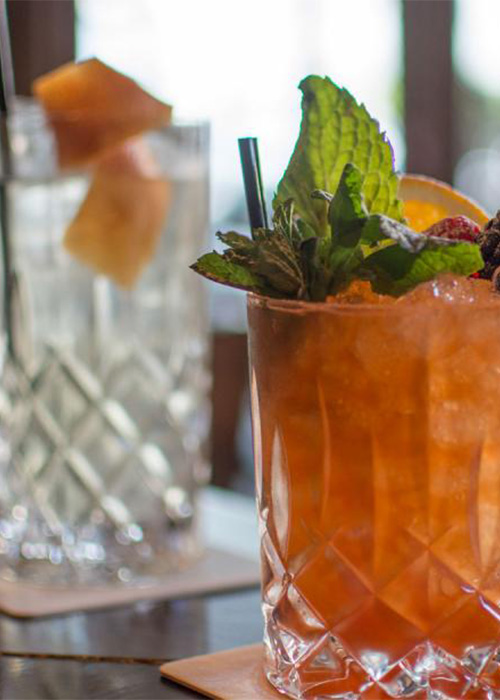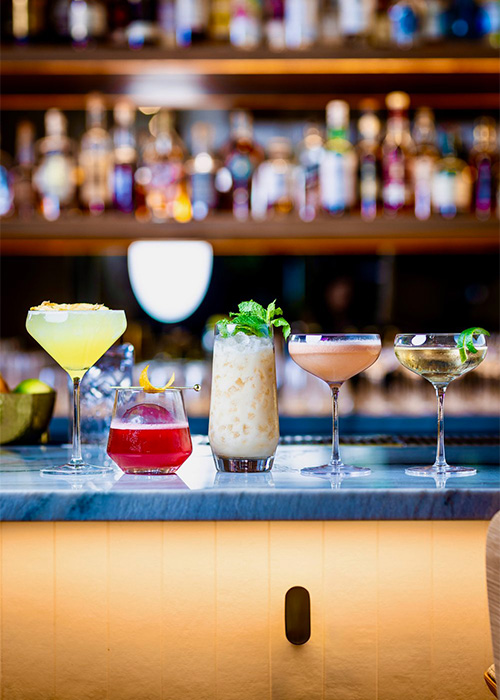The concept of fusion food and drinks is simple: to blend two (or more) vastly different cultures together to create something exploratory and delicious. Some examples like ramen carbonara, oxtail pizza, or the now ubiquitous Korean fried chicken likely come to mind. But while it’s now become commonplace to see the ingredients and dishes of two distinct European or Asian cuisines mixed and matched on one plate or in a single glass, it’s still rare to see two Black cuisines do the same and be called fusion.
Generally, when it comes to Black food and beverage, there’s an idea that it’s one size fits all, and that its many origins aren’t distinct or different enough from one another to draw a crowd. With the diversity and breadth of the Black diaspora, this notion couldn’t be more incorrect: From Haitian and Ethiopian to Ghanaian and Gullah, each point within the diaspora offers its own singular flavors and techniques worthy of both collaboration and the spotlight. But now, more bar programs and bartenders in the United States are finally exploring the vastness of Black drinking culture by blending its influences, one cup at a time.
Communal Spirits
Louisiana has long been considered the unofficial northernmost Caribbean island — the state’s Creole population is incredibly diverse— so it makes sense that bars within the city have been fusing Black American and Caribbean drinks for decades. In New Orleans, restaurant Compere Lapin is using its beverage program to celebrate some of the Caribbean’s most iconic spirits. Opened by James Beard Award-winning Saint Lucian chef Nina Compton in 2015, the establishment highlights cocktail ingredients including 10 varieties of Jamaican rums, black strap rum from St. Criox, and Clairin, a sugar cane spirit (and subcategory of white rum) native to Haiti.
Don’t Miss A Drop
Get the latest in beer, wine, and cocktail culture sent straight to your inbox.

“One of my favorite [drinks] on the current menu is the CL Daiquiri, our take on the classic cocktail,” says the restaurant’s wine director, Roxy Eve Narvaez. The Daiquiri rendition specifically contains Clairin Communal, a very popular brand of Clairin that blends four different rums from producers throughout Haiti — literally a communal Clairin.
“Combining Clairin Communal from Haiti and Marsh House Rum from [Louisiana’s] Avery Island with Luxardo, grapefruit, and lime, the CL Daiquiri hopefully makes you wonder a little more about how these age-old spirits have a story to tell,” she says.
A More Complete Cornucopia
Gregory Gourdet, chef and founder of Portland Haitian restaurant Kann, opened its sister bar Sousòl in 2022 so his guests could have a heightened and more complete Caribbean dining experience with a special emphasis on Haiti. Kann, which was recognized as the James Beard Foundation’s Best New Restaurant of 2023, is a national flagship for Haitian cuisine, and was created with follow-up Sousòl already in mind.

“We decided to take over the [Sousòl] space so we could have a harmonious experience with Kann,” says Gourdet. “If folks wanted to get a drink before or after dinner, the experiences would flow into each other. And if folks wanted to make a night of drinking and eating at Sousòl, they could. With Kann focused on telling the story of Haiti, we knew we had an opportunity to tell stories of the pan-Carribean as well in Sousól.”
Rum is an important staple in the Caribbean beverage repertoire, and each country has its own style of the spirit with its own backstory. Sousòl features rum and rhum agricole from Haiti, Jamaica, Barbados, Martinique, Guyana, and several other Caribbean nations in its bar program, along with Clairin and flavoring syrups like falernum. By utilizing a cornucopia of spices, fruits, and aromatics including jerk spices, coconut, hibiscus, jackfruit, habanero, banana, and mole, Sousòl offers a comprehensive cocktail and mocktail list. With Gourdet practicing a sober lifestyle for 15 years, offering a zero-proof menu that’s just as rich in flavor and history as its boozy equivalent was vital.
“For us, it’s important to have these options,” he says. “It’s a welcoming way to say ‘we got you’ if you don’t drink alcohol or just don’t feel like drinking alcohol tonight.”
Cultural Collaboration
Flavors, balances, counterpoints, textures, and spirits are usually the most obvious factors in how we differentiate one cuisine from another when we’re drinking. But acclaimed bartender and beverage educator Tiffanie Barriere (a.k.a. The Drinking Coach) has made her career driving home the importance of discovering where exactly these ingredients and traditions come from and why, especially as it relates to Black history. Within the continent of Africa, some beverages are distinct to certain countries, like ògógóró, a gin distilled from palm wine that’s specific to West Africa, particularly Nigeria and Ghana. Or, for example, when a guest enjoys a black tea-infused cocktail, there might be an assumption that the tea comes from Asia when it could just as likely come from Africa. If that drink is then mixed with a guava from the Caribbean, then it’s a cocktail that fuses multiple aspects of Black culture, but no one may pick that up besides the bartender — if they did their research.
In 2023, Barriere showcased this history-forward beverage education at the Food & Wine Classic in Aspen. There, she participated in a pop-up as the highlighted mixologist alongside Gregory Gourdet, acclaimed chef and owner of New York City’s Tatiana Kwame Onwuachi, and Erick Williams, owner and executive chef at Chicago’s Virtue Restaurant & Bar. Barriere curated the cocktails for the evening as each of the chefs prepared a dish that showcased their respective Haitian, Bronx-meets-Afro-Caribbean, and Southern backgrounds. The entire evening showed the power of Black fusion in the culinary world, but Barriere saw an opportunity to share the cultural complexity Black bartenders work into their drinks every day.
“Chefs have a space to incorporate culture to technique [in a way that’s different from bartenders] because a chef can make something that we grew up eating and modernize it,” she says. “You can identify the nostalgia on the plate even though it looks different but tastes like centuries of heart and soul. In [the] beverage [world], we do fusion every day; the storytelling is what we don’t get a chance to do.”


